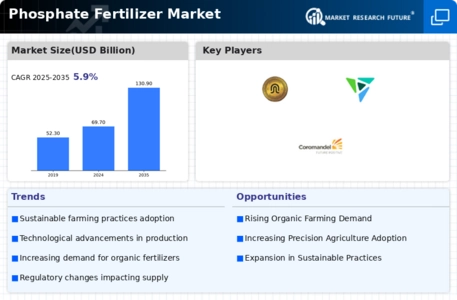Market Trends
Key Emerging Trends in the Phosphate Fertilizer Market
Phosphate fertilizer market is experiencing significant trends influenced by various factors such as increasing global population, expanding food demand, technological advancements, and environmental concerns. Phosphate fertilizers, derived from phosphate rock, play a crucial role in modern agriculture by providing essential nutrients, primarily phosphorus, for plant growth and development. One prominent trend in this market is the growing demand for phosphate fertilizers driven by the need to enhance agricultural productivity and meet the food requirements of a growing population. As global food demand continues to rise, particularly in emerging economies with expanding populations and changing dietary habits, there is increasing pressure on agricultural systems to produce higher yields and improve crop quality, driving the demand for phosphate fertilizers.
Moreover, the phosphate fertilizer market is witnessing shifts in fertilizer application practices and nutrient management strategies to optimize nutrient use efficiency and minimize environmental impact. With growing concerns about nutrient runoff, water pollution, and soil degradation associated with excessive fertilizer use, there is a growing emphasis on adopting precision agriculture techniques, balanced fertilization practices, and sustainable soil management practices to enhance fertilizer efficiency and reduce environmental risks. Manufacturers are responding to this trend by developing innovative phosphate fertilizer formulations, including slow-release fertilizers, controlled-release fertilizers, and micronutrient-enriched fertilizers, which offer improved nutrient availability, enhanced crop uptake, and reduced nutrient losses to the environment.
Additionally, the phosphate fertilizer market is experiencing technological advancements and investments in research and development aimed at improving fertilizer production processes, enhancing product quality, and developing environmentally friendly fertilization technologies. Advanced manufacturing techniques such as wet process, thermal process, and acidulation are being employed to produce high-purity phosphate fertilizers with improved solubility, uniformity, and nutrient content. Furthermore, innovations in fertilizer coating technologies, nutrient encapsulation, and nutrient delivery systems are enabling the development of next-generation phosphate fertilizers with enhanced efficiency, longevity, and environmental safety.
Furthermore, the phosphate fertilizer market is witnessing increasing adoption of sustainable phosphate sources and alternative nutrient sources to reduce reliance on finite phosphate rock reserves and mitigate environmental impacts associated with conventional phosphate mining and processing. Recycling of organic waste materials, such as animal manure, food waste, and crop residues, as organic fertilizers and soil amendments, is gaining traction as a sustainable nutrient management practice that helps close nutrient cycles, improve soil health, and reduce dependence on chemical fertilizers. Additionally, bio-based fertilizers derived from renewable biomass sources, such as biochar, compost, and microbial inoculants, are emerging as viable alternatives to conventional phosphate fertilizers, offering organic matter, beneficial microorganisms, and slow-release nutrients to enhance soil fertility and crop productivity.
Moreover, the phosphate fertilizer market is influenced by regulatory policies, trade dynamics, and geopolitical factors that impact phosphate rock production, supply chain logistics, and fertilizer trade flows. Regulatory measures aimed at promoting sustainable agriculture, reducing nutrient pollution, and conserving natural resources are shaping fertilizer markets and driving adoption of environmentally friendly fertilization practices. Trade disputes, trade agreements, and geopolitical tensions affecting phosphate rock reserves and fertilizer trade routes can also influence market dynamics and supply-demand balances, leading to price volatility and market uncertainty.
In conclusion, the phosphate fertilizer market is experiencing significant trends driven by increasing global food demand, environmental sustainability concerns, technological advancements, and regulatory pressures. As agriculture seeks to feed a growing population while minimizing environmental impact, the demand for phosphate fertilizers is expected to remain strong, with emphasis on sustainable nutrient management practices, innovative fertilizer technologies, and alternative nutrient sources. With continued investments in research and development, adoption of precision agriculture techniques, and implementation of regulatory measures to promote sustainable agriculture, the phosphate fertilizer market is poised for continued growth and evolution in the coming years.







Leave a Comment